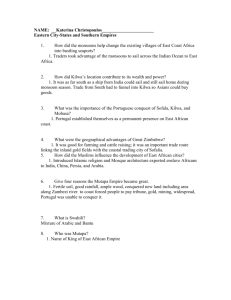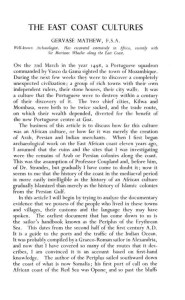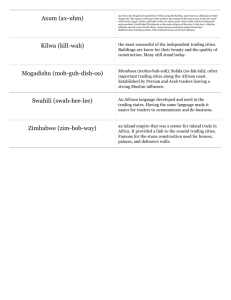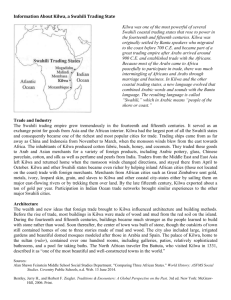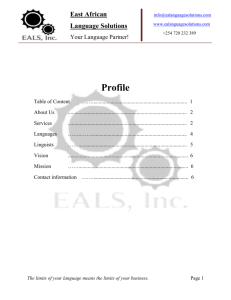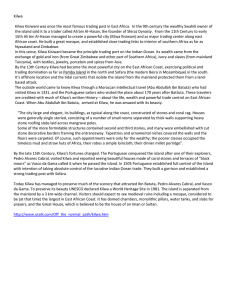CHAPTER 9: TRADING TOWNS OF THE EAST AFRICAN COAST
advertisement
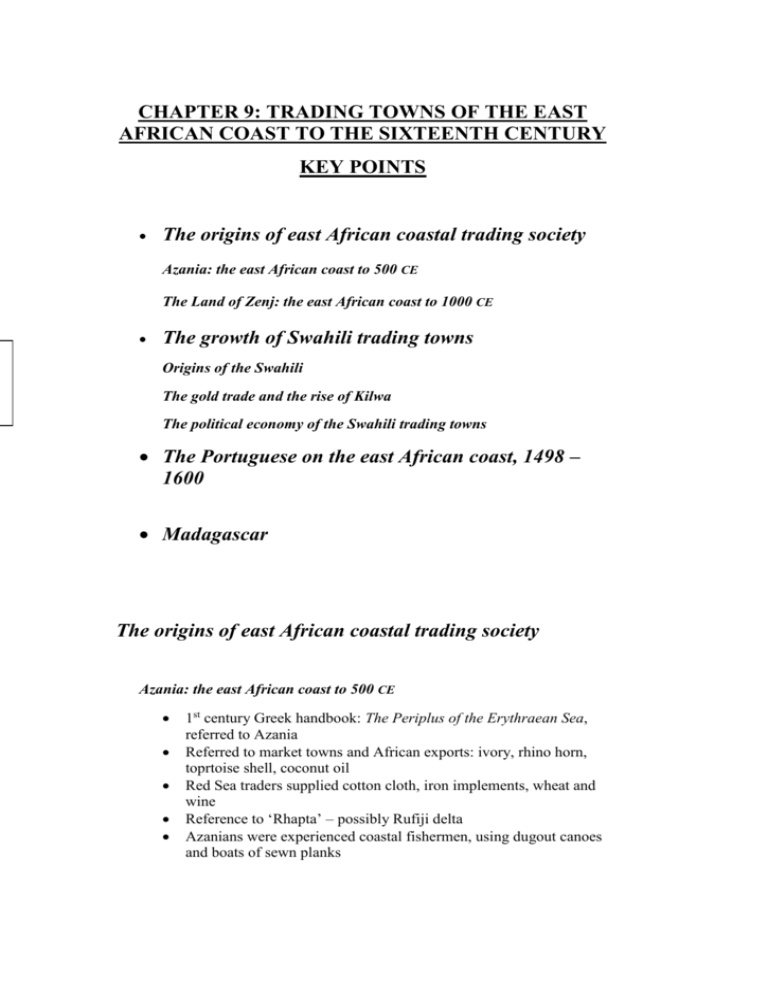
CHAPTER 9: TRADING TOWNS OF THE EAST AFRICAN COAST TO THE SIXTEENTH CENTURY KEY POINTS The origins of east African coastal trading society Azania: the east African coast to 500 CE The Land of Zenj: the east African coast to 1000 CE The growth of Swahili trading towns Origins of the Swahili The gold trade and the rise of Kilwa The political economy of the Swahili trading towns The Portuguese on the east African coast, 1498 – 1600 Madagascar The origins of east African coastal trading society Azania: the east African coast to 500 CE 1st century Greek handbook: The Periplus of the Erythraean Sea, referred to Azania Referred to market towns and African exports: ivory, rhino horn, toprtoise shell, coconut oil Red Sea traders supplied cotton cloth, iron implements, wheat and wine Reference to ‘Rhapta’ – possibly Rufiji delta Azanians were experienced coastal fishermen, using dugout canoes and boats of sewn planks They were probably peoples of the early Iron Age: they certainly were by 5th century The Land of Zenj: the east African coast to 1000 CE Spread of Islam: shift of centre to Bagdad brought Persian Gulf into Indian Ocean networks 8th century, some Shi’ite refugees from southern Arabia settled EA coast Presence of Arabic speakers eased trade relations Arabic name: ‘Land of Zenj’ Monsoon winds set seasonal trading pattern (see Map 9.2) Northern towns (Mogadishu to Lamu islands) ports of call for transocean dhows Further coastal trading southwards left in hands of local Swahili traders 9th & 10th centuries: increasing demand for ivory and gold: more Muslim merchants settle in coastal towns, marrying into local families Coastal trading towns from Mogadishu south to Comoro islands Mostly on coastal islands (Zanzibar, Kilwa): involved in trade, but still primarily African towns, cattle-keeping, domestic housing Similar local Iron Age pottery style throughout coastal region, suggesting cultural unity Mainly exporters of raw materials (ivory, ambergris, mangrove poles) Mainly importers of manufactured goods (Chinese and Persian pottery and glassware, Indian silks and cottons) Small number of slaves exported – ‘Zenj revolt’ in Basra (868 CE) Some local manufacture of beads and cotton cloth Quotation from al-Masudi’s visit of 916 [see main text p 132] The growth of Swahili trading towns Origins of the Swahili Kiswahili: from Arabic sahil/sahel (‘coast’): Bantu language with Arabic additions By 10-14th centuries, Swahili refers to distinctive coastal society:Islamic in religion and some culture, African in language and personnel From 10th – 11th century: increasing demand for gold from Fatimid Egypt Expansion of coastal trade, increasing Muslim influence on culture Rectangular houses and mosques of coral rock Prosperity of ruling elite, minting own coins for local coastal trade Fatimid dinar the currency of international trade The gold trade and the rise of Kilwa 1050-1200 Further immigration from Oman and Persian Gulf – tradition of origin from Shiraz ‘Shirazi’ settle in northern towns, and northerners move south, also claiming the status of ‘Shirazi’ heritage Rise of Kilwa because of gold trade from Sofala: Kilwa southernmost port for Monsoon sailing Gold from Zimbabwe, via Sofala in hands of local Kilwa merchants By 1200 Kilwa able to break domination of Mogadishu over international trade The political economy of the Swahili trading towns Large towns: Mogadishu, Pate, Mombasa, Malindi, Zanzibar, Kilwa Built entirely of coral rock, mainly Muslim population Small towns (more than 30), only a few stone buildings, only ruling elite Muslim Large towns under independent sultans, with authority over smaller neighbours Ruling class wealthy with many luxuries: import and export duties up to 50 per cent Kilwa and Mombasa manufacturing of beads and cotton cloth for interior trade Kiswahili-speaking, distinctly African craftsmen, artisans, clerks etc Lived in rectangular mud-brick thatched houses Adjacent mainland: traditional African farming and fishing villages Trading relations between island and mainland usually good, but some powerful sultans (e.g.Kilwa) conducted periodic raids Trading rivalry between trading towns, but rarely any violence The Portuguese on the east African coast 1498, Portuguese first Europeans to enter Indian Ocean (from south, around southern Cape) On route to India, saw wealth of Swahili gold trade and determined to seize control of it Portuguese sailed warship into harbour, demanded submission and tribute, and if denied, bombarded the town Saw this as a holy Christian war against the ‘Moors’ (Portuguese name for north African Muslims, and their general name for all Muslims) 1503, Zanzibar bombarded 1505, Kilwa and Mombasa sacked by Francisco d’Almeida [see p140 for quote] Portuguese fortresses erected at Sofala, Mozambique Island and Kilwa They hoped to gain control of the Zimbabwean gold trade Defiant Mombasa sacked again in 1528 and 1589 Portuguese built Fort Jesus at Mombasa, completed 1599 It became their east African headquarters Madagascar Uninhabited until sometime after 100 CE 100 – 400: settled by Austronesians and Bantu-speakers – they possibly arrived together from east Africa, where the Austronesians had brought the banana Further Bantu-speaking east African later settled west and south Further Austronesians possibly as late as 1500 Austronesians brought rice and banana cultivation and rectangular house-building Africans brought cattle and other farming practices By 1000 CE, Swahili traders settling north-west coast – Arabic-speaking traders brought ideas of kingship and dynasties, but adopted locally evolving Malagasy language In some areas of south Bantu languages remained until at least 14th century © Kevin Shillington, 2012
